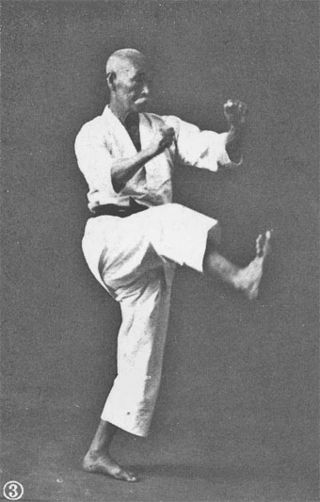
Karate (空手), also karate-do, is a martial art developed in the Ryukyu Kingdom. It developed from the indigenous Ryukyuan martial arts under the influence of Chinese martial arts. While modern karate is primarily a striking art that uses punches and kicks, traditional karate training also employs throwing and joint locking techniques. A karate practitioner is called a karate-ka (空手家).

Shotokan is a style of karate, developed from various martial arts by Gichin Funakoshi (1868–1957) and his son Gigo (Yoshitaka) Funakoshi (1906–1945). Gichin Funakoshi was born in Okinawa and is widely credited with popularizing "karate do" through a series of public demonstrations, and by promoting the development of university karate clubs, including those at Keio, Waseda, Hitotsubashi (Shodai), Takushoku, Chuo, Gakushuin, and Hosei.
Keigo Abe was a Japanese master of Shotokan karate who founded the Japan Shotokan Karate Association in 1999 and is its Chief Instructor. He held the rank of 9th dan in karate, was a direct student of Masatoshi Nakayama (1913–1987), and was a senior instructor in the Japan Karate Association.
The Japan Karate Association is one of the oldest global Shotokan karate organizations in the world.
Shotokai is the organisation formed originally in 1930 by master Gichin Funakoshi to teach and spread the art of karate-Do. Nowadays, the name also designates a formal practice method.
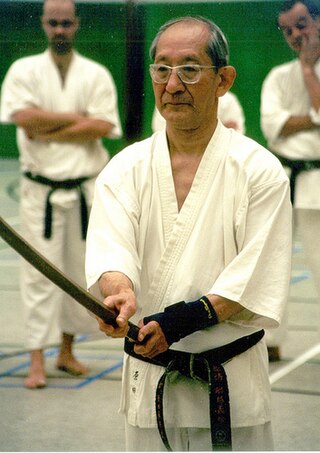
Mitsusuke Harada, MBE was a prominent Japanese master of Shotokai karate who introduced this martial art to Brazil and was after based in the United Kingdom. He founded the Karate-do Shotokai (KDS) organisation in 1965 and was its president. Harada held the rank of 5th dan, personally awarded by Gichin Funakoshi in 1956.
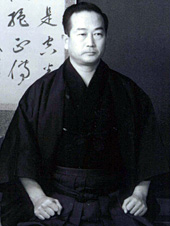
Masatoshi Nakayama[a] was an internationally famous Japanese master of Shotokan karate. He helped establish the Japan Karate Association (JKA) in 1949, and wrote many textbooks on karate, which served to popularize his martial art. For almost 40 years, until his death in 1987, Nakayama worked to spread Shotokan karate around the world. He was the first master in Shotokan history to attain the rank of 9th dan while alive, and was posthumously awarded the rank of 10th dan.
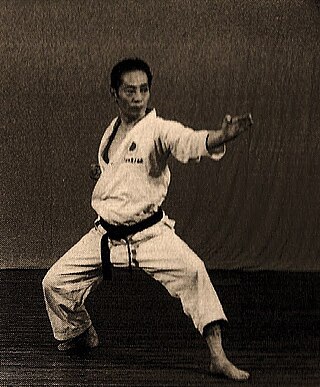
Tetsuhiko Asai was a prominent Japanese master of Shotokan karate of the Japan Karate Association (JKA), founder and Chief Instructor of the International Japan Martial Arts Karate Asai-ryu (IJKA), and founder of the Japan Karate Shoto Federation.
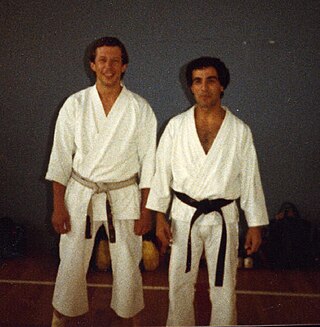
Dave Hazard is a British 7th Dan Karateka and instructor of Shotokan karate and was one of the few students present at the very beginning of British Karate. He is a former KUGB national champion and British team member. Like many of the early karateka he first trained in judo before starting karate in 1969 at the Blackfriers club in London, where he trained under Keinosuke Enoeda, Hirokazu Kanazawa, Kato and Takahashi.

Gichin Funakoshi was the founder of Shotokan karate. He is known as a "father of modern karate". Following the teachings of Anko Itosu and Anko Asato, he was one of the Okinawan karate masters who introduced karate to the Japanese mainland in 1922, following its earlier introduction by his teacher Itosu. He taught karate at various Japanese universities and became honorary head of the Japan Karate Association upon its establishment in 1949. In addition to being a karate master, Funakoshi was an avid poet and philosopher. His son, Gigō Funakoshi, is widely credited with developing the foundation of the modern karate Shotokan style.
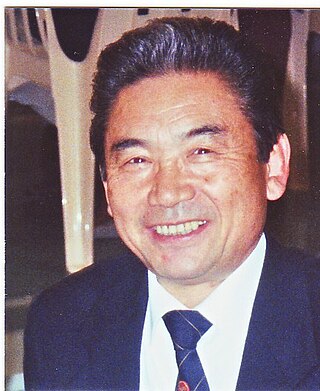
Takayuki Mikami is a Japanese master of Shotokan karate based in the United States of America. He holds the rank of 9th dan black belt in the art, awarded under the Japan Karate Association. In 1958, Mikami tied for first place in the All Japan Karate Championships. The following year, he became the All Japan champion in kumite (sparring) as well as kata (patterns). In 1961, Mikami won first place in kata again. He was also the first person to graduate from the Japan Karate Association's (JKA) instructor training program instituted by Gichin Funakoshi and Masatoshi Nakayama.

Yoseikan Karate (養正館空手) or Yoseikan Ryu Karate (養正館流空手) is the name given to the variant of Shotokan Karate taught at the Yoseikan Dojo in Shizuoka, Japan, under the direction of Minoru Mochizuki.

Yutaka Yaguchi was a Japanese karateka who was the Chief Instructor and Chairman of the International Shotokan Karate Federation (ISKF) Mountain States Region. He was born in Hiroshima, Japan, in 1932 and began karate training in 1952. He later tested under masters Gichin Funakoshi for his 1st dan black belt and Masatoshi Nakayama for his 2nd through 8th dan black belts. As one of the first graduates of the Japan Karate Association (JKA) Instructors' Training Program in 1959, he played an important role in the growth of JKA karate and the internationalization of Shotokan karate. Yaguchi first arrived in the United States on June 5, 1965. In 1974, Yaguchi founded the ISKF of Colorado, the regional headquarters for the Mountain States Region.

Kenkojuku is a style of Shotokan karate previous to the establishment of the Japan Karate Association (JKA) style. It was founded by Tomosaburo Okano. Kenkojuku karate is similar to the teachings of Gichin Funakoshi and modifications made by Funakoshi's son Yoshitaka Funakoshi. JKA Shotokan differs slightly in that it was Masatoshi Nakayama's version of Shotokan. Okano's/Yoshitaka's Kenkojuku karate and JKA karate are becoming more similar compared to other variants of Shotokan karate such as Shigeru Egami's Shotokai, Hirokazu Kanazawa's Shotokan Karate International or SKI.

Keinosuke Enoeda was a Japanese master of Shotokan karate. He was a former Chief Instructor of the Karate Union of Great Britain. Enoeda was ranked 8th dan in Shotokan karate, and was widely renowned as a formidable karateka. Following his death, Enoeda was posthumously awarded the rank of 9th dan.

Taiji Kase was a Japanese master of Shotokan karate who was one of the earliest masters responsible for introducing this martial art into Europe. He taught his style of karate, Shotokan Ryu Kase Ha, in France from the late 1960s to the mid-1980s. In his later years, he travelled across the world teaching karate, but Paris remained his home. Kase held the rank of 9th dan in karate.
Isao Obata was a pioneering Japanese master of Shotokan karate. He was a senior student of Gichin Funakoshi, who is widely recognized as the founder of modern karate, and was a key figure in the establishment of the Japan Karate Association (JKA) under Funakoshi in 1949. Obata also helped introduce karate to the United States of America through his demonstrations of the art to United States Air Force personnel, and through his students, most notably Tsutomu Ohshima.
Japan Shotokan Karate Association (JSKA) was founded by Keigo Abe in 1999. Abe was a former instructor graduate of the Japan Karate Association and trained and taught at the JKA Headquarters for nearly 35 years. He held a number of senior positions within the JKA and latterly the Matsuno section of the JKA. He had been a senior student of Nakayama and as such the teachings of Nakayama remain an integral part of the evolution of the Shotokan style within the JSKA. Abe Sensei died on December 20, 2019. And he was awarded a posthumous 10th Dan by the JSKA Shihankai on his passing. The current Chief Instructor is Mitsuru Nagaki, 9th Dan, a student of Abe and former instructor with the Japan Karate Shotorenmei.
Stan Schmidt was a South African master of Shotokan karate. Along with others, such as Norman Robinson, he was an early practitioner of Shotokan karate in South Africa and his establishment of the South African branch of the Japan Karate Association (JKA) in 1965 after training in Japan, along with his subsequent promotion of the art in South Africa, earned him the appellation of 'The Father of South African Karate'. In 1963, he was one of the first westerners to be invited into the JKA's famous Instructor Class in the Tokyo Honbu dojo and he was later one of four non-Japanese karateka to sit on the JKA's international Shihankai. He was also the first non-Japanese karateka to attain 7th dan from the JKA and also the first to attain 8th dan. Today, he is the highest ranking non-Japanese karate master of that organization. He is also known for his acting roles in several martial arts films of the 1970s and 1980s.












